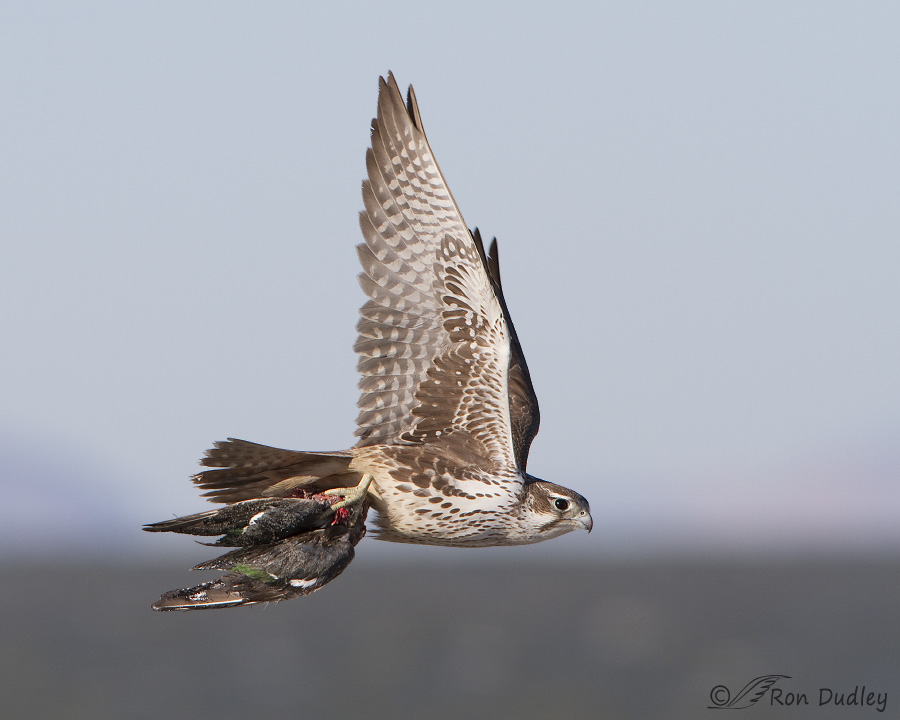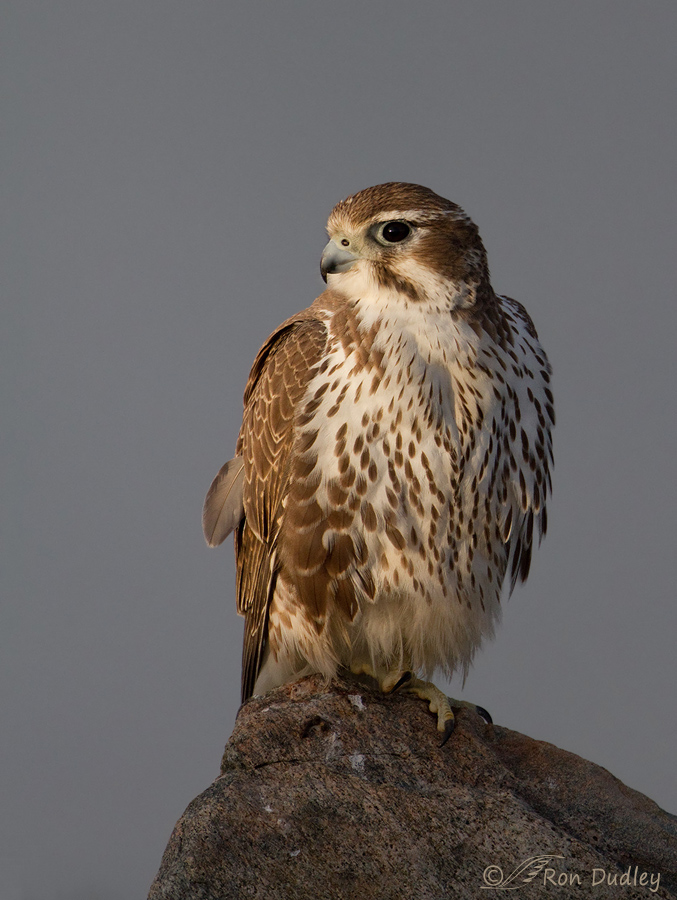For some time I’ve been threatening to post a few older photos that I’ve posted before because it’s been so long that many current blog followers have never seen them. This first image is one of them.
I was just leaving Antelope Island on a cold and windy December day after a disappointing morning of attempting to photograph birds (they were all hunkered down in the wind) when I encountered this young Prairie Falcon feeding on what I believe is a Shoveler near the marina. Almost immediately a pair of harassing ravens forced the falcon into the air with its partially eaten prey.
 1/1600, f/6.3, ISO 500, Canon 7D, Canon EF 500mm f/4L IS USM, not baited, set up or called in
1/1600, f/6.3, ISO 500, Canon 7D, Canon EF 500mm f/4L IS USM, not baited, set up or called in
I was able to get off a couple of sharp shots as the bird headed east along the causeway and this is my favorite of the two. The falcon then crossed the causeway road in front of me and was immediately attacked by a marauding adult Bald Eagle. Under normal circumstances the falcon could easily out-maneuver the eagle but dragging this heavy load made it vulnerable so it dropped the duck onto the ice where the eagle retrieved it and flew off. Naturally, all that occurred on the wrong side of my pickup for me to get any shots of it.
The plane of the falcon’s body is tipped a little because of the heavy load it’s hauling. The dark gray background at bottom is the “angry” Great Salt Lake – it often looks like this in windy and stormy conditions and the vague white blobs in the water are out of focus whitecaps. The duck’s feathers have granular ice and snow pellets stuck to them.
Whether by accident or by design I think it’s interesting that the falcon has grasped the duck in the way that it’s most streamlined going through the air – reminds me just a little of how an Osprey carries a fish in flight.

This photo, taken about a month earlier, is of the same falcon. I know that because of the broken feather on the right wing, though it can’t be seen in the first photo above. This image was taken right at dawn just as the light hit the bird but hadn’t yet reached the perch. I don’t have the techs for this shot easily available but I know it was taken at a high ISO setting.
I’ve had very few opportunities with Prairie Falcons this winter and that’s at least partly due to the receding Great Salt Lake. With very little water near the causeway road there’s also relatively few ducks there for falcons to prey on so they generally stay too far out for the reach of my lens. I did get close to a Prairie Falcon yesterday morning but that was at Farmington and the bird was perched on an ugly power pole in poor light.
Rest easy, I won’t be posting any of those shots.
Ron


Wonderful Ron!
Charlotte
Beautiful portrait!
Such a beautiful killer. 😀
Survival is hard enough without the worry of being mugged for your food. Thievery obviously uses less energy reserves. Sigh.
Love that streamlined ‘carry’ pose. I suspect experience if not instinct has honed and reinforced that habit.
“I suspect experience if not instinct has honed and reinforced that habit”
You may be right, EC – perhaps with falcons it’s learned but instinctual in Osprey.
No, they don’t read those books! And there’s also the issue that I’m talking in a falconry context, too.
Wild birds tend to take what’s easiest/safest, as do most other raptors. When they’re learning their skills as young birds, if they’re unsuccessful with larger game, they don’t go back to it–ever. That’s a survival thing. They don’t waste time/energy if they’re not successful the first couple of times. If they are successful, they keep on going, honing their skills to become even more successful. Combine that individual factor (bell curve) with what’s available to them in various regions, plus the falcon/tiercel component and you get a lot of different results.
Cottontails also vary in size across the west. So there are all sorts of variables to consider, including that most of our knowledge is based on a few humans (comparatively) watching only a few individuals (compared to the total population) over a comparatively short period of time. Now that we’re watching nesting behavior over time with nest cams, we’re finding a lot of the things we used to think we knew are not true.
All sorts of things happen in The Great Out There that we haven’t witnessed. Here’s an example: A friend’s 850-gram male redtail caught a fox–knocked it out cold! Obviously that’s not an everyday occurrence, but it happens. In falconry, if you’re doing it right, you’re building the bird’s confidence to where it owns its prey base and takes whatever it wants to take. At least that’s how I believe it works.
You make some good (and interesting) points, Laura. Thank you.
I work at the Boulders Golf Resort in Scottsdale/Carefree AZ and I see these Falcons way high on the boulders. Rabbits are their steady diet.
Wow, that’s something I’ve never seen. I think the rabbits around here are too big for them.
Nope, prairies catch rabbits routinely–particularly the falcons (females, not so much the males/tiercels). They’re kinda like redtails in they’re not real fussy and will take whatever they can get.
Hmmm, I just read the entire (long) BNA account on “Food Habits” of Prairie Falcons and if there was any mention of them taking rabbits I missed it. The closest I could find is Pikas. I guess falcon’s don’t read so they don’t know what they’re supposed to eat… 🙂
Falconers have called prairies the redtail of the longwing world because they’ll take anything they can get. They’re not fussy (like a redtail). In the Snake River Canyon area of Idaho, Morley Nelson said their primary prey is ground squirrels.
Spectacular, plus the redundantly repetitive standing WOW! 😀
And that pilfering thing is why bald eagles are my least favorite raptor. And yes, I know that pilfering is a time-honored survival strategy, it’s just that when it becomes a habit, it gets annoying.
I’ve thought seriously about flying a tiercel prairie one day, but I’d have to move west. Oh DARN!
“I’ve thought seriously about flying a tiercel prairie one day”
It was my understanding (perhaps wrong?) that they’re pretty high strung for falconry purposes, Laura. What say ye?
Yes, I’ve heard that too about the passage birds, but moreso with the females. But I love the challenge. And every time I see a bunch of pigeons/doves sitting peacefully on a wire without a care in the world, I get all annoyed. They SHOULD have a care!
This Kestrel is certainly challenging me. She was supposed to be at hunting weight today. We actually have sunshine until later this afternoon, and she’s, well, pudgy. Thankfully, Jack is ready, so we’ll go harass the little voles/mice in about an hour.
This is just one of the reasons Golden Eagles NOT Bald Eagles are such favorites of mine….you said it well….
The image quality in your photos is remarkable. Even though we shoot the same gear (albeit, yours in newer with the USM II and TC iii), you’re pics are head and shoulders above what I can get. And I may be in the minority, but I wouldn’t mind seeing your ugly perch shots in poor light as I am more interested in the IQ captured under less than ideal conditions than how pretty the bird is. More of a tech/camera/best practices kind of guy and I always am eager to see & learn what others are up to and their techniques employed.
Thanks, Zaphir – actually, these shots were taken with the older version of the lens, not the IS II and I made an error in my techs (which I’ve since corrected) – I wasn’t using a tc for that first shot.
In a few minutes I’ll email you one of those shots of a falcon on a pole that I took yesterday but don’t expect much…
Beautiful Falcon, Ron!! I do feel for the poor guy who never did get to keep his catch!! Watching the eagle cams has started my interest in other Rapters and has spread to all our wonderful birdlife. As I’ve watched cams and followed your blog, I’ve definitely learned that many birds are opportunistic hunters and is what they need to do to survive. So I know this prairie Falcon will probably have “stolen” another bird’s catch!!! Thanks for another great bird “tale”, Ron!!!
“I do feel for the poor guy who never did get to keep his catch”
Jo Ann, Bald Eagles are pilfering experts – it’s just what they do. I’m sure it didn’t take long for this falcon to find another meal because that bird hung around the causeway for a long time after this encounter with the eagle and it seemed to be thriving.
These are both beautiful images…so glad you “threatened” (treated?) us with them…they are new to me. Looks like that poor, beleaguered hawk at least got something to eat judging by what appears t,o be a swollen crop. I llove the feather detail in both…the underwing feather patterns in the first and everything about the second. Some of your photos may be “old”, but as long as the birds and behaviors you’ve captured still exist, they’re still relevant and therefore interesting. Please remember that….and don’t apologize for them….ever!
Thanks for your support for these older images, Patty. I won’t post them often but occasionally I likely will.
I’ve run out of superlatives, but I like both images very much.
Thanks very much, Dave.
Great shots as usual, Ron.
Shame you didn’t get the Eagle.
Had a similar experience with an Eagle stealing a fish from an Osprey – to far away – but what a sight!
“Shame you didn’t get the Eagle”
Dick, missing those shots has grated on me for a long time…
Great shot, Ron! Even with a load they sure can move fast. I’m always amazed at how much they can carry. No match for an eagle under those circumstances for sure.
“I’m always amazed at how much they can carry”
Judy, even with part of this duck eaten it’s still a pretty heavy load for the falcon to carry in flight. I believe this is the same bird that learned to strike its duck prey as it sat on the water, killing it, and then wait for the waves to bring it to shore before claiming it. It probably did this because the ducks were too heavy to be lifted out of the water.